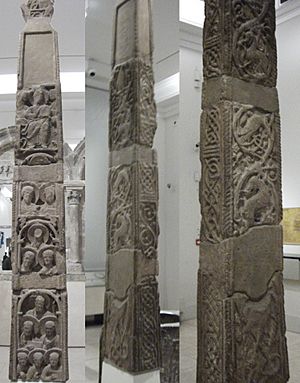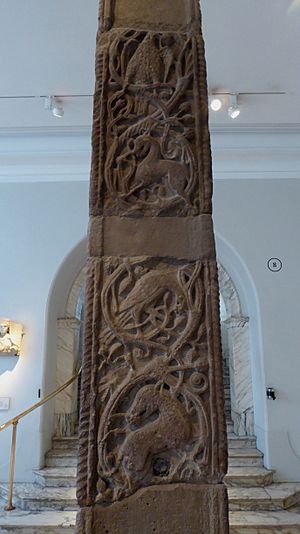Easby Cross facts for kids
The Easby Cross is a very old stone cross made by the Anglo-Saxons. It was carved from sandstone between the years 800 and 820. Today, you can see this amazing cross in the Victoria and Albert Museum in London.
It originally stood in a place called Easby, which is near Richmond in North Yorkshire. Back then, this area was part of a powerful kingdom called Northumbria. A copy of the cross is still kept in the church at Easby. The cross was once very tall, reaching up to 3 meters (about 10 feet) high.
Contents
What is the Easby Cross?
The Easby Cross is a type of standing cross. These crosses were common in early medieval Britain and Ireland. They often had detailed carvings and were used as monuments or markers.
How the Cross Survived
Only four pieces of the original cross still exist. These pieces have been put together to show what the cross looked like. Three of these fragments were found in the church at Easby. They had been used as building stones when the church was rebuilt many years ago.
One piece, showing Christ in Majesty, was found in a field wall nearby. It was later sold to the Victoria and Albert Museum. It was common for old crosses to be broken up and reused like this. Some parts of the cross even show old repairs made with melted lead, meaning it might have been damaged before it was broken apart.
Where Did the Stone Come From?
The stone used for the Easby Cross is quite special. It's a type of sandstone that didn't come from Easby. Instead, it came from quarries near Whitby, which is almost 60 miles away! This stone was also used for Whitby Abbey and other sculptures. The large stone pieces were likely moved by pack horses, perhaps after they had already been carved.
What Can You See on the Cross?
The Easby Cross is covered in beautiful carvings. These carvings tell stories and show important figures.
The Front and Back Carvings
The front of the cross has carvings of people. One part shows Christ in Majesty, which means Jesus as a powerful ruler, with two angels. Below this, there were once groups of apostles (Jesus's followers) with halos. The cross used to have arms, making it wider, but these are now missing.
The back of the cross has a continuous pattern called a "vine scroll." This pattern looks like twisting vines and is "inhabited" with different animals. This was one of the first times this kind of design appeared in Anglo-Saxon art.
The Side Carvings
The two narrower sides of the cross have different patterns. They show a mix of interlace (a pattern of woven lines) and vine scrolls. These patterns don't match exactly on both sides, which is unusual. The corners of the cross have a rope-like pattern running down them.
Why is the Easby Cross Important?
The Easby Cross was made during a special time for Anglo-Saxon art. It was when important Anglo-Saxons, like Alcuin, worked with the famous ruler Charlemagne. They stayed in touch with monasteries in Northumbria.
The Easby Cross is considered one of the best Anglo-Saxon crosses that still exists. It is similar to other crosses from Northumbria, like those found in Otley and Ilkley. It also shares some features with the older Ruthwell Cross and Bewcastle Cross, which are even bigger.
The cross was made around 800–820 AD. This was just as the "golden age" of Northumbrian art was ending. This period saw the start of terrible Viking raids, which began with an attack on Lindisfarne in 793 AD.
Today, you can see the Easby Cross at the start of the Medieval galleries in the Victoria and Albert Museum in London.
Images for kids





